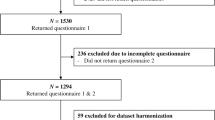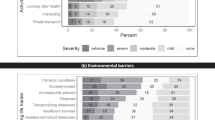Abstract
Study design:
A cross-sectional, validation study.
Objectives:
To (a) develop the Spanish version of the Quality of Life Index-Spinal Cord Injury version (SV-QLI/SCI) and (b) assess its psychometric characteristics among permanent wheelchair users and specifically among those with SCI.
Setting:
Associations of wheelchair users in Mallorca (Spain).
Methods:
Two forward and backward translations of the QLI/SCI into Spanish were carried out separately. Seventy-seven subjects were randomly selected among the members of the associations. They completed the SV-QLI/SCI and validated instruments to measure depression and spinal pain upon recruitment and 14 days later. Assessments included comprehensibility, reproducibility, floor and ceiling effects and correlations between quality of life, pain and depression (Spearman's correlation coefficient). Analyses were repeated excluding data from subjects without SCI.
Results:
Three items of the SV-QLI/SCI required rephrasing. Reproducibility was ‘almost perfect’ for the entire questionnaire and its ‘Health and functioning’ subscale, ‘substantial’ for the ‘Social and economic’ and ‘Family’ subscales and ‘moderate’ for the ‘Psychological/spiritual’ subscale. Floor effect was not observed, and only for the ‘Family’ subscale >3% of the subjects reached the maximum possible score. The correlation between quality of life and depression was the strongest (r=−0.628). Results were virtually identical in the subsample with SCI.
Conclusion:
These results support the use of the SV-QLI/SCI among Spanish-speaking wheelchair users.
Similar content being viewed by others
Log in or create a free account to read this content
Gain free access to this article, as well as selected content from this journal and more on nature.com
or
References
Hallin P, Sullivan M, Kreuter M . Spinal cord injury and quality of life measures: a review of instrument psychometric quality. Spinal Cord 2000; 38: 509–523.
Hill MR, Noonan VK, Sakakibara BM, Miller WC . SCIRE Research Team.Quality of life instruments and definitions in individuals with spinal cord injury: a systematic review. Spinal Cord 2010; 48: 438–450.
Evans RL, Hendricks RD, Connis RT, Haselkorn JK, Ries KR, Mennet TE . Quality of life after spinal cord injury: a literature critique and meta-analysis (1983-1992). J Am Paraplegia Soc 1994; 17: 60–66.
Dijkers M . Quality of life after spinal cord injury: a meta-analysis of the effects of disablement components. Spinal Cord 1997; 35: 829–840.
May LA . Warren SMeasuring quality of life of persons with spinal cord injury: external and structural validity. Spinal Cord 2002; 40: 341–350.
May LA, Warren S . Measuring quality of life of persons with spinal cord injury: substantive and structural validation. Qual Life Res 2001; 10: 503–515.
Whitehurst DG, Engel L, Bryan S . Short form health surveys and related variants in spinal cord injury research: a systematic review. J Spinal Cord Med 2014; 37: 128–138.
Guillemin F, Bombardier C, Beaton D . Cross-cultural adaptation of health-related quality of life measures: literature review and proposed guidelines. J Clin Epidemiol 1993; 46: 1417–1432.
Huskinson EC . Measurement of pain. Lancet 1974; 2: 1127–1131.
Radloff LS . The CES-D scale: a self-report depression scale for research in the general population. Appl Psychol Meas 1977; 1: 385–401.
Landis JR, Koch GG . The measurement of observer agreement for categorical data. Biometrics 1977; 33: 159–174.
Bland JM, Altman DG . Statistical methods for assessing agreement between two methods of clinical measurement. Lancet 1986; 327: 307–310.
Scutter S, Turker KS, Hall R . Headaches and neck pain in farmers. Aust J Rural Health 1997; 5: 2–5.
Johanning E . Back disorders and health problems among subway train operaors exposed to whole body vibration. Scand J Work Environ Health 1991; 17: 414–419.
Kovacs FM, Abraira V, Zamora J, Fernández C . Spanish Back Pain Research Network. The transition from acute to subacute and chronic low back pain. A study based on determinants of quality of life and prediction of chronic disability. Spine 2005; 30: 1786–1792.
Kovacs FM, Abraira V, Zamora J, Gil del Real MT, Llobera J, Fernández C . The Kovacs-Atención Primaria Group. Correlation between pain, disability and quality of life in patients with common low back pain. Spine 2004; 29: 206–210.
Acknowledgements
We thank the Kovacs Foundation, a not for profit private Institution with its own funding and with no links to the health industry, for having funded this study. No benefits in any form have been or will be received from a commercial party related directly or indirectly to the subject of this article. We do not have any financial or personal relationships with third parties that could influence this work inappropriately. This study was funded by the Kovacs Foundation, a not for profit private Institution with its own funding and with no links to the Health industry.
Author information
Authors and Affiliations
Corresponding author
Ethics declarations
Competing interests
The authors declare no conflict of interest.
Additional information
Supplementary Information accompanies this paper on the Spinal Cord website
Supplementary information
Rights and permissions
About this article
Cite this article
Kovacs, F., Barriga, A., Royuela, A. et al. Spanish adaptation of the Quality of Life Index-Spinal Cord Injury version. Spinal Cord 54, 895–900 (2016). https://doi.org/10.1038/sc.2015.200
Received:
Revised:
Accepted:
Published:
Issue date:
DOI: https://doi.org/10.1038/sc.2015.200
This article is cited by
-
Prevalence and factors associated with a higher risk of neck and back pain among permanent wheelchair users: a cross-sectional study
Spinal Cord (2018)
-
A validity study of the Spanish—World Health Organization Quality of Life short version instrument in persons with traumatic spinal cord injury
Spinal Cord (2018)



